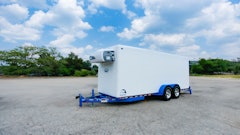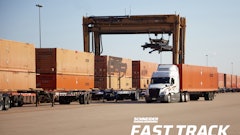
IoT has revolutionized the cold chain. From meat trucks tracked across continents to smart reefers that monitor strawberries in real time, connected sensors and cloud platforms have reshaped how we safeguard food, medicine, and biologics.
Retailers can see a shipment's thermal history before it hits the loading dock. Logistics providers can dispatch technicians when a compressor falters, not after it fails. In food logistics, these capabilities can represent many fewer lost dollars in food spoilage and maintenance costs.
But in our rush of excitement, we often get things wrong. Technology alone does not guarantee product integrity, and the connected cold chain is characterized by both breakthroughs and blind spots. Too often, what sounds like progress ends up as a pile of CSVs, half-integrated gadgets, or networks that mysteriously go dark the moment you need them most.
To understand the best practices to follow, it is important to first understand the pitfalls. In this case, those pitfalls are represented by a rogue’s gallery of archetypes that plague cold chain initiatives. Being aware of them and how to avoid them is critical in an industry where there is little room for refrigerated regret.
The data hoarder
Like a dragon sitting on a mountain of gold it never spends, this archetype confuses endless telemetry with actual insight.
Mechanism: Collect all the sensor data, all the time. Gigabytes of temperature readings per truck, per hour, just to prove you can.
Culprit: The IT or engineering team that confuses “having data” with “using data.” Spoiler: S3 buckets are not a strategy.
When it fails: The first time someone asks, “So… which shipment was actually compromised?” and all you’ve got is a CSV file the size of “War and Peace”.
Why it persists: Dashboards are fun to demo. It is oddly satisfying to show executives a real-time map with little blinking dots moving across the country. Never mind that the actual question (“Do we need to throw away this pallet of strawberries?”) remains unanswered.
Why it fails/what to do instead: Data is only valuable when it reduces decision latency. "Collect everything” is not a best practice, but following that with a meaningful action is. Translation: if your reefer truck door opens for 17 seconds in Wichita, Kan., do you need a push notification? Or would you rather know whether that event actually matters biologically and requires action or intervention?
Key question: Does this data point change an operational decision, or is it just something to brag about in a slide deck?
The Frankenstein stack
A living museum of half-integrated gadgets, duct tape, and one sacred Windows XP laptop keeping it all alive.
Mechanism: Glue together legacy thermometers, SMS-based trackers, cloud APIs, and maybe a Raspberry Pi duct-taped under the pallet.
Culprit: The operations director who wishfully insists “We’ll just integrate what we’ve already got” while glaring at the budget spreadsheet.
When it fails: Integration Week. Always integration week. Suddenly, the Bluetooth logger does not talk to the cellular gateway, and the firmware only works with a Windows XP laptop you keep under lock and key.
Why it persists: Ripping and replacing hardware is scary and expensive. Plus, everyone secretly believes they are just one custom script away from “seamless interoperability.”
Why it fails/what to do instead: Connected cold chains are already complex. Don’t add unnecessary entropy. Avoid hardware with connectivity lock-ins and proprietary ecosystems. Adopt modularity as a religion: use standardized protocols and modern languages (LoRaWAN or BLE sensors, MQTT, JSON, and SQL) and insist that every new piece of kit plugs into a broader orchestration layer without hand-written glue code.
Key question: If the one engineer who made it all work quits tomorrow, how much of your cold chain program would survive?
The Wi-Fi whisperer
This optimist assumes connectivity is everywhere, like oxygen, until the truck hits a cellular dead zone or its sole wireless carrier experiences an outage.
Mechanism: Connect to whatever network is available. Trucks, ports, warehouses, rural highways–surely there will be a Wi-Fi router or a cell tower nearby, right?
Culprit: The business leader who heard a vendor say it would work everywhere, stopped asking questions, or just ended up using the same carrier the business gets its cellphones through.
When it fails: Right about the time your container ship drifts out of the range of your cellular network, or your truck route crosses that patch of Idaho where carrier coverage maps lie like bad Tinder profiles.
Why it persists: We’re all spoiled by Netflix buffering faster than we can blink at home. We forget that industrial connectivity involves moving metal boxes full of liquid nitrogen through cellular dead zones.
Why it fails/what to do instead: Build resilience in layers. Wi-Fi for the garage, an IoT SIM with multicarrier cellular and cross-carrier failover for the road, and LPWAN NTN Satellite for sending high-value low-data updates in dead zones, and store-and-forward logic so that data survives the trip even if connectivity does not. Connectivity should be “best effort + redundancy,” not “blind faith in signal bars.”
Key question: What happens to your compliance reporting if you lose connectivity for 48 hours?
The compliance cop
Armed with binders and PDFs, this archetype believes paperwork is the same thing as product integrity.
Mechanism: Do everything for the auditors. Every process, every system, every alarm tuned to produce maximum PDF output.
Culprit: The quality assurance manager whose love language is paperwork.
When it fails: When compliance replaces competence. Sure, you passed the audit, but customers are still getting thawed chicken strips.
Why it persists: Regulations are real, scary, and expensive to ignore. Companies optimize for the measurable risk (fines) instead of the existential risk (angry or sick customers).
Why it fails/what to do instead: Treat compliance as the floor, not the ceiling. Best practice is designing for operational excellence that also produces compliance artifacts automatically. Imagine: no one filling in forms at 2 a.m., but your system still outputs the perfect PDF trail when the auditor comes knocking.
Key question: Would this connectivity-powered process still make sense if compliance were not a factor at all?
The AI alchemist
Forever seeking algorithmic gold, this character promises predictive magic while quietly ignoring the trust gap in the room.
Mechanism: Throw machine learning at the problem. Predict spoilage with 99% accuracy using a model no one understands, trained on data no one trusts.
Culprit: The innovation lab desperate to justify its budget.
When it fails: The first time the model flags 40% of shipments as “suspicious,” and operations has no idea what to do except… throw them away?
Why it persists: AI demos are catnip. To be fair, pattern recognition can be powerful. But, the leap from “interesting anomaly detection” to “trustworthy, actionable prediction” is massive.
Why it fails/what to do instead: Focus on explainability. Use AI where it simplifies human decision-making, not replaces it. For example, highlight “This truck shows 3 times more door opens than the fleet average,” not “Neural net spells doom.”
Key question: Would you trust this model enough to bet a consumer’s health on it?
The actual best practices
Once you understand what does not work, you can avoid it by focusing on what does work. Much of that involves embracing the notion that sensors, connectivity, data collection methods, and AI are means, not ends. Rather than embracing the wrong archetypes, try this:
- Design for decision, not data: Every sensor, integration, or algorithm should reduce the time it takes to act.
- Build for modularity, not heroics: Systems should survive personnel changes. A connected cold chain is not an artisanal one-off project.
- Engineer for failure, not perfection: Assume connectivity drops, sensors drift, batteries die. Build fail-safes that degrade gracefully.
- Compliance as exhaust, not engine: Generate compliance naturally from operational excellence. Don’t let paperwork define the system.
- Use AI as amplifier, not Oracle: If the algorithm does not make sense to the person using it, it is not helping.
Conclusion: Use the rogue’s gallery as a toolbox
Think of the connected cold chain as a heist movie. Entropy is the villain. Your tools–sensors, networks, software–are the crew. If you embrace the wrong archetypes, the job collapses into chaos. But if you get the right decision-centric sensors, modular integrations, resilient networks, and factor in compliance as an outcome by design (and not the only goal), you can pull it off.
Unlike the movies, the stakes for companies in the food logistics chain are not bags of cash, but whether millions of dollars in food shipments arrive in a condition that ensures the food is safe to eat. That is not a job to leave to just anyone.
Key final question: When entropy knocks on your refrigerator door, are you building a system that lets the right people know in time to take action?




















